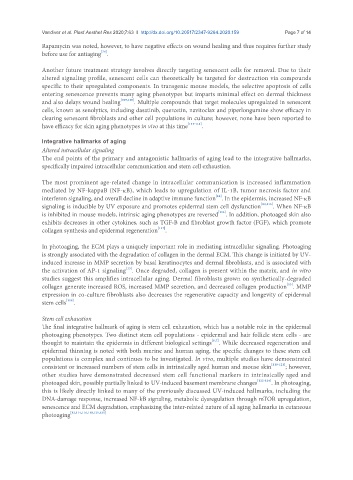Page 743 - Read Online
P. 743
Vandiver et al. Plast Aesthet Res 2020;7:63 I http://dx.doi.org/10.20517/2347-9264.2020.159 Page 7 of 14
Rapamycin was noted, however, to have negative effects on wound healing and thus requires further study
[74]
before use for antiaging .
Another future treatment strategy involves directly targeting senescent cells for removal. Due to their
altered signaling profile, senescent cells can theoretically be targeted for destruction via compounds
specific to their upregulated components. In transgenic mouse models, the selective apoptosis of cells
entering senescence prevents many aging phenotypes but imparts minimal effect on dermal thickness
and also delays wound healing [109,110] . Multiple compounds that target molecules upregulated in senescent
cells, known as senolytics, including dasatinib, quercetin, navitoclax and piperlongumine show efficacy in
clearing senescent fibroblasts and other cell populations in culture; however, none have been reported to
have efficacy for skin aging phenotypes in vivo at this time [111-114] .
Integrative hallmarks of aging
Altered intracellular signaling
The end points of the primary and antagonistic hallmarks of aging lead to the integrative hallmarks,
specifically impaired intracellular communication and stem cell exhaustion.
The most prominent age-related change in intracellular communication is increased inflammation
mediated by NF-kappaB (NF-kB), which leads to upregulation of IL-1B, tumor necrosis factor and
[16]
interferon signaling, and overall decline in adaptive immune function . In the epidermis, increased NF-kB
signaling is inducible by UV exposure and promotes epidermal stem cell dysfunction [82,115] . When NF-kB
is inhibited in mouse models, intrinsic aging phenotypes are reversed [116] . In addition, photoaged skin also
exhibits decreases in other cytokines, such as TGF-B and fibroblast growth factor (FGF), which promote
collagen synthesis and epidermal regeneration [117] .
In photoaging, the ECM plays a uniquely important role in mediating intracellular signaling. Photoaging
is strongly associated with the degradation of collagen in the dermal ECM. This change is initiated by UV-
induced increase in MMP secretion by basal keratinocytes and dermal fibroblasts, and is associated with
[13]
the activation of AP-1 signaling . Once degraded, collagen is present within the matrix, and in vitro
studies suggest this amplifies intracellular aging. Dermal fibroblasts grown on synthetically-degraded
[13]
collagen generate increased ROS, increased MMP secretion, and decreased collagen production . MMP
expression in co-culture fibroblasts also decreases the regenerative capacity and longevity of epidermal
stem cells [118] .
Stem cell exhaustion
The final integrative hallmark of aging is stem cell exhaustion, which has a notable role in the epidermal
photoaging phenotypes. Two distinct stem cell populations - epidermal and hair follicle stem cells - are
thought to maintain the epidermis in different biological settings . While decreased regeneration and
[6,7]
epidermal thinning is noted with both murine and human aging, the specific changes to these stem cell
populations is complex and continues to be investigated. In vivo, multiple studies have demonstrated
consistent or increased numbers of stem cells in intrinsically aged human and mouse skin [119-121] ; however,
other studies have demonstrated decreased stem cell functional markers in intrinsically aged and
photoaged skin, possibly partially linked to UV-induced basement membrane changes [122-124] . In photoaging,
this is likely directly linked to many of the previously discussed UV-induced hallmarks, including the
DNA-damage response, increased NF-kB signaling, metabolic dysregulation through mTOR upregulation,
senescence and ECM degradation, emphasizing the inter-related nature of all aging hallmarks in cutaneous
photoaging [82,114,116,118,121,125]

